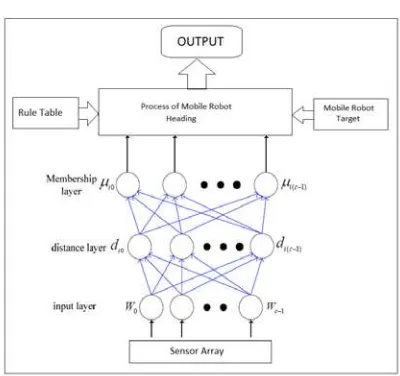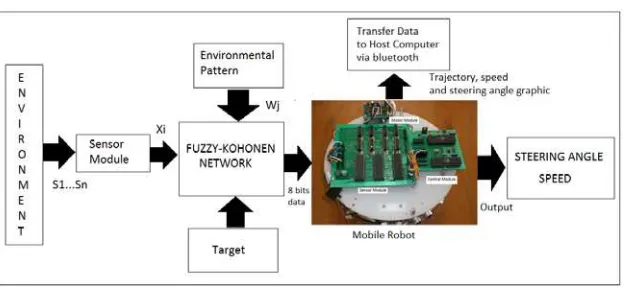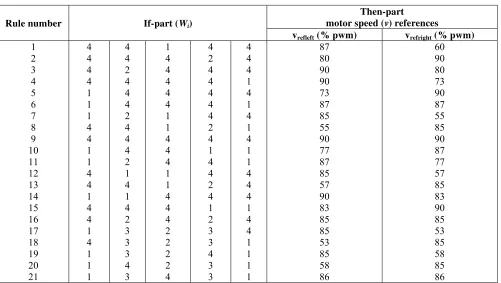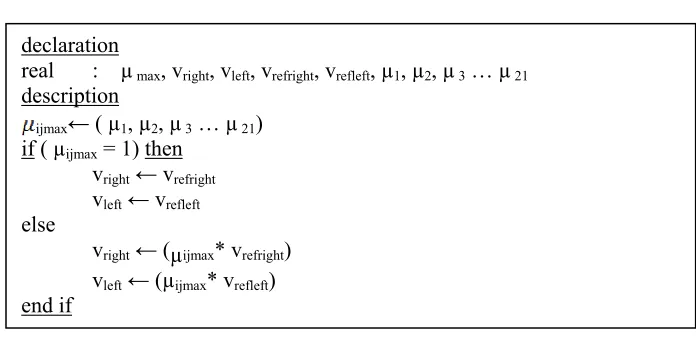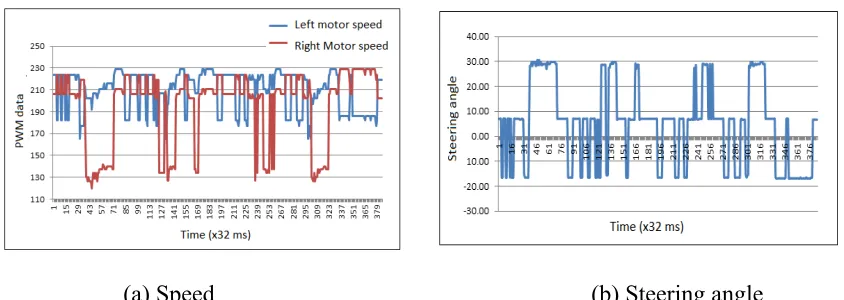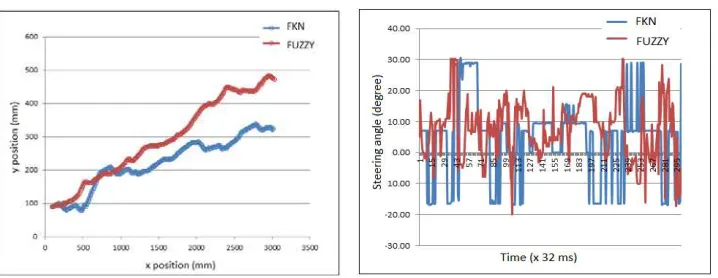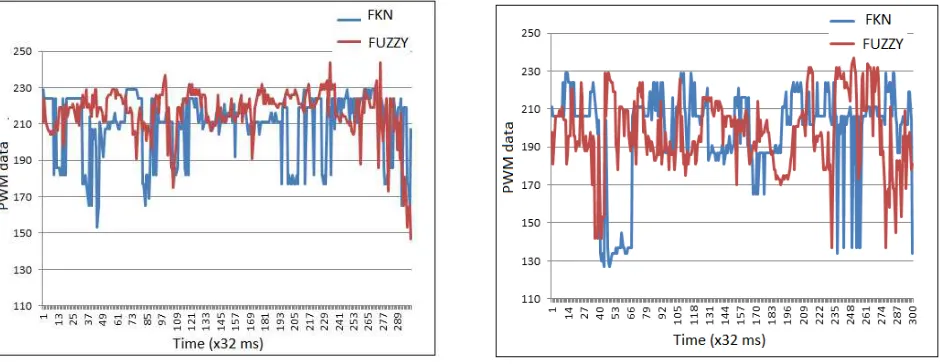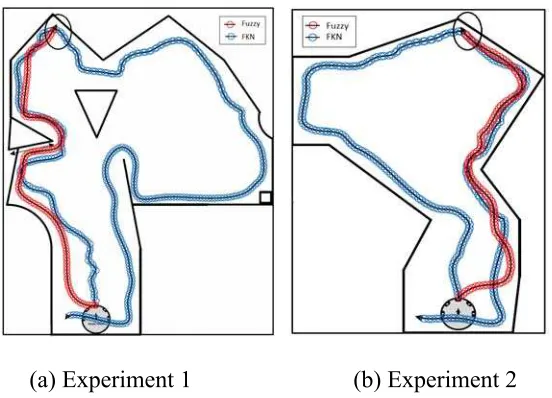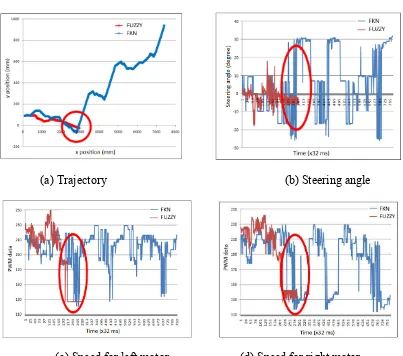ISSN 1450-216X Vol.72 No.2 (2012), pp. 228-244 © EuroJournals Publishing, Inc. 2012
http://www.europeanjournalofscientificresearch.com
Intelligent Navigation in Unstructured Environment by using
Memory-Based Reasoning in Embedded Mobile Robot
Siti Nurmaini
Department of Computer Engineering, Faculty of Computer Science University of Sriwijaya, Jl. Raya Palembang-Prabumulih
Km 32, Inderalaya-Ogan Ilir, Indonesia E-mail: siti_nurmaini@unsri.ac.id
Aditya Putra P.
Department of Computer Engineering, Faculty of Computer Science University of Sriwijaya, Jl. Raya Palembang-Prabumulih
Km 32, Inderalaya-Ogan Ilir, Indonesia E-mail: aditrecca@gmail.com
Rendyansah
Department of Computer Engineering, Faculty of Computer Science University of Sriwijaya, Jl. Raya Palembang-Prabumulih
Km 32, Inderalaya-Ogan Ilir, Indonesia E-mail: rendy@unsri.ac.id
Tel: +62-711379249; Fax: +62-711-379-248
Abstract
Keywords: Memory-based reasoning, Embedded mobile robot, Fuzzy-Kohonen Network, Navigation, Unstructured Environment.
1. Introduction
Mobile robot navigation in unknown environments has been one of the active research areas in robotics. This requires a number of heterogeneous capabilities like ability to reach a given location in real time to unexpected events, to determine the robot's position, and to adapt the environmental changing. Recently, mobile robot is being extensively used in various fields stretching from simple actions to their advanced implementation. Each implementation of mobile robot implies particular concepts and engineering solutions able to deal with problems emerging on the different level (Yamada, 2004). Their main focuses on developing navigation methodologies for realizing accurate, reliable localization and map generation from uncertain data obtained by high sensitive sensors (Schmitt et al., 2002; Meyer and Filliat, 2003; Luh and Liu, 2008). Most studies on such research have explored to design a precise geometric map for identifying their environment (Elfes, 1987; Asada, 1990; Fichtner and Grobmann, 2004).
The visual sensors provide the richer source of useful information about the environmental surroundings. However, it have drawbacks such as, slow in processing data, the global information like vision may not be obtained in a dark room and expensive in cost (Yamada, 2004; Marichal et al., 2009). In the real world, numerous natural agents like animals to recognize their environments just with low sensitive sensors without a geometric map (Yamada, 2004). They must learn to recognize new environment by itself. Therefore, a robot not need to be expensive but should be intelligent and adaptive in unknown environments. Hence, it is essential to design a simple robot with low cost sensors that are able to recognize environment. Nevertheless, it has difficulty handling a modification of the environment, due to some uncertain in each environmental situations. Moreover, the reactive navigation capabilities are indispensable since the real-world environments are appropriate to change over time (Saffiotti, 1997; Yang and Meng, 2000; Bonarini et al., 2003).
A goal of mobile robot navigation methods is to realize a safe and efficient movement. Safety means mobile robot does not collide with obstacles and efficiency means it can reach a destination in a small amount of time. Furthermore, if the cost of sensing is considered, but observing uncertainty-minimizing environments may not be optimal in terms of the cost of reaching a target (Miura, 2006). Therefore, it is necessary to consider what accuracy is needed in each environmental situation. Nevertheless, these requirements are usually in a trade-off relationship. If the mobile robot moves quickly to increase efficiency, the number of observations usually decreases and uncertainties in localization and environment recognition thus increase; this most probably decreases safety. If the mobile robot moves slowly to increase safety, efficiency decreases.
There are numerous techniques that deal with the uncertainty, cost and efficiency requirements such as fuzzy logic (Tunstel et al., 2002; Aguirre and Gonzalez, 2003; Hagras, 2004), heuristics (Song and Sheen, 2000), potential field (Sekiguchi et al., 2006), particle swarm optimization (Huang et al., 2006), neural network (Hui and Pratihar, 2004), immunological (Luh and Liu, 2008) and their hybrids (Zhu and Yang, 2007; Hui and Pratihar, 2009). However, during the mobile robot traversal the ‘local minima’ or ‘infinite loops” problem (i.e., cycling between multiple traps) may still occur in some cases. Traps can be created by a variety of obstacle configurations. Some researchers have proposed several methods (Saffiotti, 1997; Aguirre and Gonzalez, 2003; Yang et al., 2004; Vadakkepat et al., 2005; Zhu and Yang, 2007; Deng et al., 2010). Nevertheless, these methods cannot guarantee that the mobile robot will not trapped on infinite loops and the computationally is expensive. This drawback can decrease the mobile robot performance especially when operating on embedded platform with modest capabilities in terms of speed and memory (Nurmaini, 2011).
If these constraints are imposed a priori, the advantages of controllers can be lost. To overcome the limitation the choice of simple algorithm is highly desirable to cope with the memory and time limitations. This is especially important for designing agile compact autonomous devices where the computational and energy requirements are usually very restrictive (Altrock, 1998; Tunstel et al., 1994). Therefore, the limited computational resources available to an embedded mobile robot often present challenge. Although the aforementioned techniques successfully solve the mobile robot navigational problem, there always remains a need of lowering the system cost further without compromising much on its efficiency and reliability (Nurmaini, 2012).
Navigation in embedded mobile robot not only avoid obstacles based on the sensor input but also comprehend the nature of its environment, remember over time such comprehended scenarios, recollect them and associate in time perceptions of environment that resemble each other. Such requirements demand spatial and temporal reasoning capabilities, for considering the mobile robot environmental as an experience of a sequence of sensor patterns. To react efficiently and robustly, the memory-based reasoning must integrate to another requirement to perform navigation tasks is capability to overcome uncertainty and imprecision in complex and unpredictable environment. The implementation of strategies for incorporating memory properties to determine control strategy, can be reduces computational cost.
These problems have been a central driving force behind the design a simple control technique in a manner that overcomes such limitations in embedded mobile robot. As a proposed solution, in this paper a simple fuzzy-neural control technique is developed, to realize navigation control in low cost embedded mobile robot with low sensitive and local sensors. Fuzzy-kohonen network (FKN) technique is utilized, to integrate supervised learning ability and rule base of the fuzzy logic. This technique describes that reduces to order such experiences to achieve the necessary spatial and temporal reasoning properties by using memory-based reasoning. The strategies are the mobile robot must have capability to recognize and memorize the environments, building the desired mapping between the perception of the human knowledge and the exact motion of the mobile robot. It demonstrates in unstructured and unknown environment with ‘local minima’ situation. The result founds that it reasonably good performance while navigating in such environments compare to fuzzy logic system.
2. Fuzzy-Kohonen Network in Embedded Mobile Robot
Figure 1: FKN structure
To deal with the limitations, a simple technique for making navigational decision is needed. Soft computing such as fuzzy logic, neural network, evolutionary algorithm and their hybrid can be successfully integrated into an embedded controller design (Hagras et al., 2000; Yang et al, 2004; Simoes, 2008). It provides effective methods and improves the mobile robot navigation performance (Hoffmann, 2000). Fuzzy-Kohonen clustering network (FKCN) is one type of hybrid technique which is the result of integration between fuzzy logic and Kohonen network proposed by Huntsberger and Ajjimarangsee (1990). FKCN technique is certainly based on an unsupervised learning, due to this learning process thus produces high computational cost, requires intensive processing and needs large storage capacity (Song, and Sheen, 2000). In this work, to make this technique simplicity, the originality of unsupervised learning process reduces to supervised named, fuzzy-kohonen network (FKN). In this strategy Kohonen network has the advantage of learning mechanism while the fuzzy logic plays a role in managing the input and output process of pattern recognition (Nurmaini, 2011). The structure of the FKN is equipped with three layers as shown in Figure 1. Several input patterns are used in the training phase.
There are many initial patterns, which represent a characteristic pattern in every layer. To reduce the space complexity and to facilitate fast learning of sample sequences by the FKN, all these patterns are set as a weight in the distance layer and for calculating these weights, the rule base table is utilized instead of being trained. The number of rules equals that of initial patterns. Every initial pattern is derived from previous experimental data base. The pattern is assigned and associated with a pair of motor speed reference. This research different with works of Song and Sheen (2000) and Tsai et al (2010), due to in this research all process of the navigation control based on low cost 8 bits microcontroller and inexpensive infra-red sensor. Therefore, the algorithm must produce simple resources, for making the faster controller in the process and robust in the implementation. The algorithm navigation control procedure to determine the design purpose can be seen in Figure 2.
The method for learning rules to determine the distance and similarity between input pattern and initial pattern are described in the following steps:
Step 1: Create input patterns (Xi). It is constructed from current sensor readings (si) are fed to
the neural network input, the formula as follow,
i
Step 2: Activate the Kohonen network by applying the input vector Xi and find the winner-takes
all (WTA) neuron. The idea behind the winner selection is that the network tries to find the values which are most similar to the current input vector. For most application standard way of measuring this similarity is to compute Euclidian distance (dij). These values responsible for comparing the input
pattern Xi with every initial pattern Wj.
Step 3: Once the similarity value is obtained by using the Euclidean distance, then the degrees of membership µij is calculated. To obtain these values, linear function is used, as shown in Figure 3.
Figure 3: Linear function
In this paper to simplify the algorithm, the max value f of Euqlidian distance is obtained from experimental result due to the sensor reading by using equation (3),
2
To describe a linear function utilize equation (2) and (3) as a membership degree μij. If the input
pattern does not match any initial pattern, then the similarity value is represented by membership value
1, 0
Operation of the mobile robot must be reactive in the changing and in the unstructured environment, it means, the mobile robot should be capable of reacting to unexpected environment simultaneously for achieving a goal. This situation is motivated by the fact that motion makes sensory information becomes absolute more rapidly. The most important property of a reactive control system is its fast reactions; this implies some environmental pattern from sensor perception to action and small amounts of computation on the changing environment.
Figure 4: Mobile robot platform
Figure 4 shows a block diagram of embedded mobile robot platform and control system based on FKN technique. In block diagram, mobile robot is responsible for generating motor steering and speed command in response to embedded controller.
3.1. Classifies of Sensors Values
In this work, the mobile robot use n sensors to extract more information about surroundings in unknown and changing environment. Five infra-red low cost sensors are mounted in a circle on the mobile robot 45o apart. To reduce the space complexity and to facilitate fast learning of sample sequences by FKN is used that maps each sample us to a particular class. The FKN can be trained on a sequence of one-dimensional classes rather than a sequence of five-dimensional sensor samples. Initially the five infra-red sensors are grouped into three groups namely left, center and right as shown in Fig. 3. Only one sensor s3 in group 1 is used to detect obstacles at the front of mobile robot. Two
sensors s1, and s2, in group 2 are used to detect obstacle at left side and two sensor s4 and s5 in group 3
1,2 1,2
where, Xi are the grade value and si are the minimum distance value from infra-red sensor of the ith
group and s1, s2 … si are threshold values for quantization. Evidently there can be other ways of
classifying the range reading to classes. The reason to have specified the range readings in terms of far is 4, medium is 3, near is 2 and very near is 1. There are essentially due to the same kind of partitioning employed in the fuzzification part of the inference scheme for collision avoidance. After the distance values from the sensors are quantized, the output becomes the input to the FKN. This value need to compare the input pattern (Xi) with the initial pattern (Wj). The algorithm for determining the Euclidian
distance (dij) and similarity value ( ij) between the input patterns and the initial patterns is described in
Figure 5.
Figure 5: Simple algorithms to obtain similarity value
3.2. Environmental Classification
An experience of spatio-temporal patterns is modeled to summarize all environmental patterns. Each sample of such pattern consists of range readings obtained by five sensors. For reducing complexity of storage, representation and learning a long sequence of each sample is mapped to one class by FKN. In order to enable the mobile robot to avoid the obstacles with reactive action, the better mapping relation between the sensor data as input and the speed control as output must be established; due to the distribution of obstacle is complex. Since the obstacle exists in mobile robot direction and the width of obstacle is less than the measurement width of sensors, the mobile robot can recognize the environmental pattern. If the mobile robot detects an obstacle in the front, left, right or two sides, it can determine the navigation path. However, the ‘danger’ condition like u-shape is always occurred, therefore special control scheme has to be given. The mobile robot will reduce the speed first and then turn to the right/left, when it detects simultaneously an obstacle in all direction.
Figure 6: Several typical of environments
Figure 6: Several typical of environments - continued
In this work infra-red sensors installed in mobile robot can be classified as 21 of environmental pattern categories as shown in Figure 6. All possibilities of mobile robot environmental are considered through fuzzifying process and combining these 21 classes of rule base in Table 1. The rule table is constructed exploiting the sequence of environmental pattern and speed levels. In this strategy 21 rules are employed to kept few compare to conventional fuzzy control technique. Our mobile robot is equipped with two wheels on both side and one free wheel at the front of mobile robot. The two parallel wheels are driven by direct current (dc) motors. Its sequence is determined by the relative references speeds of the left and right wheels. Therefore, each initial pattern is associated with a couple of reference speeds. In this work mobile robot target is assigned to kept simplicity.
Table 1: Rule base
Rule number If-part (Wi)
Then-part motor speed (v) references
3.3. Speed Control of Mobile Robot
In mobile robot navigation, speed control analysis gives information about and mobile robot’s left and right speed over the time. By using FKN technique, after the rule base and similarity patterns (μij) are
known, the mobile robot speed (v) is determined by finding rule that has the highest level of similarity (μmax). The final value is calculated with multiplied by level similarity with the speed references (vref).
The simple algorithm for generating DC motor speed can be seen in Figure 7. The results of mobile robot speed than conversion to pulse width modulation (PWM) data, namely the percentage of duty cycle. Duty cycle is determined within a few percentage points, to obtain some value. By regulating the duty cycle of PWM, to obtain the speed of DC motor and steering angle. This value can be used to control mobile robot movements. The formula PWM as follows:
PWM = duty cycle (%) x 255 (5)
Figure 7: Simple algorithms to control motor speed
4. Experimental Results and Discussion
In this section practical navigation experiments are conducted employing a self-constructed mobile robot. The effectiveness, robustness and comparison of various systems for embedded mobile robot are done using single stage fuzzy technique and our proposed simple neuro-fuzzy technique. In order to verify the effectiveness of the proposed solution, experimental is set-up on real embedded mobile robot. Low cost microcontroller 8 bit Alf and Vegard's Risc processor (AVR) 8535 with 8 Kbytes flash memory is designed for central navigation as onboard controller. The specified traveling nominal speed in these experiments is 20 cm/s. The mobile robot has maximum speed of vmax = 90% of duty cycle of PWM. The data from experimental result is obtained by using hyper-terminal strategy in a real time. Embedded Bluetooth is used for sending the experimental data from mobile robot to personal computer. For evaluating our proposed technique, experiments are conducted including simple, complex and unstructured environment, moreover unstructured obstacle as traps.
4.1. Structured Environment
This section conducts three experiments, one in simple environment and two experiments in complex environment. The experiments utilize twenty one environmental patterns, for investigating the influence of FKN technique in terms of steering angle, speed and movement performance. The input vectors (test data) from sensor are given to the FKN which is trained in initial experiment. After learning with training data, the initial data is created from the sensing of an unstructured environment, are given to the learned FKN. All the initial data are identified and verified the utility of our technique. From the experimental results, mobile robot based on proposed hybrid technique is correctly identified
simple environment, and achieves good performance. The recorded graph of the mobile robot speed and steering angle when avoid the wall as shown in Figure 8.
Figure 8: Mobile robot performance based on FKN in simple environment
(a) Speed (b) Steering angle
In complex environment, we dealt with more noise like unstructured obstacles. As depicted in Figure 9, the mobile robot position is located in two locations in structure complex environment. As stated earlier, mobile robot performance based on FKN compare to fuzzy logic systems.
Figure 9: Complex environment
robot’s left and right speed over the time. Shows in Figure 10 (c) and 10 (d), left and right wheel speed control, in differential drive mechanism, to take right turn; robot increases its left speed and decreases right speedy and vice versa.
Figure 10: Mobile robot performances in complex environment (position 1)
(a) Trajectory (b) Steering angle
(c) Speed for left motor (d) Speed for right motor
In order to verify the effectiveness of the proposed technique, mobile robot is set up in several environments. In Figure 11(a)-(d) presents the experimental result of the mobile robot in complex environment, indicating the effectiveness and applicability of the proposed technique. As depicted in Figure 11 (a), the mobile robot will not move into the concave region and therefore navigate successfully to the target. Based on FKN technique, it reaches the target faster compare to fuzzy logic technique. Due to it can recognize the environmental pattern by considering memory-based reasoning.
Figure 11: Mobile robot performances in complex environment (position 2)
Figure 11: Mobile robot performances in complex environment (position 2) - continued
(c) Speed for left motor (d) Speed for right motor
Figure 11 (b)-(d) presents the recorded mobile robot speed of both wheels and the steering angle in complex environment. They can be used to check the maneuvering when the mobile robot navigating as it encounters obstacles. In this situation the ‘local minima’ situation was not activated. The results reveal that the proposed technique is capable of smoothly steering the mobile robot over this complex environment. The experimental result shows that memory-based reasoning indicates the improving mobile robot navigation performance.
4.2. Unstructured Environment
The second experiment is performed in unstructured environment. An unstructured environment is a type of environment that has no specific pattern. A well-known drawback in unstructured environment is that the mobile robot suffers from ‘danger’ problems in that it uses only locally available environmental information without any previous memorization. Traps can be created by a variety of obstacle configurations. The key issue to that problem is the detection of the ‘danger’ situation during the mobile robot’s traversal. Figure 12 (a) and 12 (b) presents an experimental result in which the mobile robot navigating in unstructured environment in two experiments. The recorded trajectory reveals that the mobile robot can avoid the obstacles safely. However, in the acute angle situation mobile robot based on fuzzy logic cannot continue to move to the target as shown in Figure 12. In the absence of spatial cognition followed by memorizing and retrieval leads to the following reasoning the mobile robot gets into a local minimum situation. The mobile robot had to explore in unknown environment employing its onboard controller.
Figure 12: Mobile robot movements in unstructured environment
(a) Experiment 1 (b) Experiment 2
Care should be taken to note that in this instance the mobile robot actually does not detect a “danger situation” by correlating similar experiences. In contras of mobile robot based on FKN technique can recognize the entire environmental situation and can reach the finish without trapped in the concave environment. The same with experiment 2 as shown in Figure 12 (b), these results suggest that in the case of unstructured environment FKN technique are preferred. This is due to of the fact the fuzzy logic output in the unexplored regions of inputs is not predictable and error at each stage gets accumulated and hence do not give stable movements. In concave obstacle, FKN technique by considering memory-based reasoning brings the mobile robot out of the trap.
Figure 13 presents the mobile robot experimental result in unstructured environment with several acute angles. The mobile robot trajectory in experiment 1 is illustrated in Figure 13 (a). From Figure 13 (b) shows that the recorded of mobile robot steering angle performance based on FKN technique compare to fuzzy logic in experiment 1 and experiment 2. It can be used to check the maneuvering of the mobile robot as it encounters obstacles. But in the u-shape situation the mobile robot-based on fuzzy logic cannot continue to run and reach the target. In contrast to mobile robot based on FKN successfully to recognize the environment, achieve smooth trajectory and traveling to the target. The recorded of mobile robot speed of both wheels as shown in Figure 13 (c), and 13 (d). By using fuzzy logic system, the mobile robot reduces the speed and stop the processes in second 14, thus the controller does not send the command to the motor. Otherwise mobile robot based on FKN successfully environmental travelling, after escaping from the recursive concave environment, the mobile robot reaches target.
Figure 13: Mobile robot performance in unstructured environment (experiment 1)
Figure 13: Mobile robot performance in unstructured environment (experiment 1) - continued
(c) Speed for left motor (d) Speed for right motor
Figure 14: Mobile robot performance in unstructured environment (experiment 2)
(a) Trajectory (b) Steering angle
(c) Speed for left motor (d) Speed for right motor
4.3. Local Minima Situation
Numerous experiments are conducted to demonstrate the performance of mobile robot navigation employing FKN technique to various complex unstructured environments, in particular, the capability of escaping from the traps or the wandering situations described. Several researchers have proposed the control strategy to overcome the problem by designing several control strategy (Luh and Liu, 2006; Zhu and Yang, 2007), however, the ‘local minima’ may still happen. For example, a mobile robot wanders in definitely in a loop inside a U-shaped obstacle, because it does not has memory about the initial pattern of the environment, and its navigation is only based on the local sensed environment. In this paper, using the information acquired from the sensor array, the memorizing control strategy in tends to find a safe way to circumvent any collision to guide the mobile robot out of the traps. The navigation strategy is based on the recognizing of local sensed environment, thus the FKN actively selects a movement direction from sets of possible direction in a rule base table. Once initial pattern in the rule table have been established the FKN will produce desired robot heading for escape the trap.
Figure 15: Mobile robot in complicated situation without suffering from the ‘local minima problems
(a) U-Shape (b) Complex case
Figure 15 (a) and (b) show the mobile robot meets different situation, due to a long wall with U-shaped area is located in the complex environment. The recorded of mobile robot movement of both ‘local minima’ situation in this experiment is presented in Figure 15(a) and 15(b). It can be seen from Figure 15 (b) that when the mobile robot wanders infinite loops, which are a loop inside U-shaped obstacle, using the rule-base table the ‘local minima’ situation path under the control of the rules. In the experiment, memory-based reasoning strategy is developed for the system in navigation chips. The mobile robot change the strategy if the distance between the mobile robot and obstacle in current situation same as the distance in navigation memory. In this study by using FKN technique the mobile robot can recognize and memorize the environmental situation, this strategy produce good action to guide the mobile robot out of the traps. It has a great potential in the fields of machine learning, computer science and Engineering due to it has the following features: self-organizing, memorization, recognition, adaptation, and learning.
5. Conclusion and Future Work
number of the fuzzy rules so that the simple navigation strategy has been proposed to steer the mobile to reach the target. The proposed technique is presented in this work is promising and is able to predict the mobile robot in unstructured environment, to make the collision avoidance system more robust or flexible. Furthermore, proposed FKN technique mobile robot is able to navigate in an unstructured unknown environment and it has capability to escape from U-shaped situation. For the future work, we need to investigate on how to extend and expand the proposed technique that is to make it more general to all unstructured environments taking into considerations both static and dynamic obstacles by using multiple robots.
Acknowledments
Authors thank to Higher Education General Director (DIKTI), the Ministry of National Education Department, Indonesia for their financial support in Competitive Grants Project.
References
[1] Aguirre, E and Gonzalez, A, 2003. A Fuzzy perceptual model for ultrasound sensors applied to intelligent navigation of mobile robots. Applied Intelligence 19: 171–187.
[2] Altrock, V.C, 1998. Adapting existing Hardware for Fuzzy Computation. Handbook of Fuzzy Computation, Institute of Physics Publishing.
[3] Asada, M. 1990. Map building for a mobile robot from sensory data. IEEE Trans. Syst. Man Cybernet. 20(6) 1990, pp.1326–1336.
[4] Baturone, I., Moreno-Velo, J.F., Blanco, V. and Ferruz, J, 2008. Design of embedded DSP-based fuzzy controllers for autonomous mobile robots. IEEE Transaction on Industrial Electronic, 55(2), 2008, pp. 928-936.
[5] Bonarini, A., Invernizzi, G., Labella, H. and Matteucci, M, 2003. An architecture to coordinate fuzzy behaviors to control an autonomous robot. Fuzzy Sets and Systems, 134(1), 2003, pp. 101–115.
[6] Deng, M., Inoue, A., Sekiguchi, K., and Jiang, L, 2010. Two-wheeled mobile robot motion control in dynamic environments. Robotics and Computer-Integrated Manufacturing, 26, 2010, pp. 268–272
[7] Elfes, A, 1987. Sonar-based real-world mapping and navigation. Int. J. Robot. Autom. 3(3),pp. 249–265.
[8] Er, J.M., and Zhou, Y, 2008. A novel framework for automatic generation of fuzzy neural networks. Neurocomputing, 71, pp. 584–591.
[9] Fichtner, M. and Grobmann, A, 2004. A probabilistic visual sensor model for mobile robot localization in structured environment. IEEE international conference on Intelligent Robots and System, Sendai Japan, pp. 1890-1895.
[10] Hagras, H., Callaghan, V. and Colley, M, 2000. Online learning of the sensors fuzzy membership functions in autonomous mobile robots”. Proc. of IEEE Int. Conf. Robot. Autom., San Francisco, CA, pp. 3233–3238.
[11] Hagras, H, 2000. A hierarchical type-2 fuzzy logic control architecture for autonomous mobile robots. IEEE Transc. On System Man and Cybernetic, 2004,
[12] Hoffmann, F, 2000. Soft computing techniques for the design of mobile robot behaviors. Information Science, 122, pp. 241-258.
[13] Huang, Y., Sun, D., and Qin, Q, 2006. Path planning of mobile robot based on particle swarm optimization algorithm. Ordnance Industry Automation. 25(4), pp. 49-61.
[15] Hui, B.N., and Pratihar, K.D, 2009. A comparative study on some navigation schemes of a real robot tackling moving obstacles. Robotics and Computer Integrated Manufacturing, 25, 810-828.
[16] Huntsberger, T.L., and Ajjimarangsee, P, 1990. Parallel self-organizing feature maps for unsupervised pattern recognition. International Journal General Systems, 16(4), pp. 357-372. [17] Luh, C.G., and Liu, W.W, 2008. An immunological approach to mobile robot navigation.
Motion Planning. In-Tech Open, pp. 291-318.
[18] Meyer, A.C., and Filliat, D, 2003. Map-based navigation in mobile robots: A review of map-learning and path-planning strategies. Cognitive System Research, 4(4), pp. 283-317.
[19] Marichal, G.N., Hernandez, A., Acosta, L., and Gonzalez, J.E, 2009. A Neuro-fuzzy system for extracting environment features based on ultrasonic sensors. Sensors, 9, pp. 10023-10043. [20] Miura, J., Negishi, Y., and Shirai, Y, 2006. Adaptive robot speed control by considering map
and motion uncertainty. Robotics and Autonomous Systems 54, pp. 110–117.
[21] Nurmaini, S, 2011. Intelligent Low Cost Mobile Robot and Environmental Classification. International Journal of Computer Applications. 35(12), pp. 1-7.
[22] Nurmaini, S, 2012. Development Mobile Robot Control Architecture with Integrated Planning and Control on Low Cost Microcontroller. Journal of Theoretical and Applied Information Technology. 35(1), pp. 100-111
[23] Saffiotti, A, 1997. The uses of fuzzy logic in autonomous robot navigation. Journal Soft Computing, 1(4), pp. 180–197.
[24] Song, K.T. and Sheen, L.H, 2000. Heuristic fuzzy-neuro network and its application to reactive navigation of a mobile robot. Fuzzy Sets and Systems, 110(3), pp. 331–340.
[25] Schmitt, T., Hanek, R., Beetz, M., Buck, S., and Radig, B, 2002. Cooperative probabilistic state estimation for vision-based autonomous mobile robots. IEEE Transc. on Robotic and Automation, 18(5), pp. 670-684.
[26] Sekiguchi K, Deng M, Inoue A, 2006. Obstacle avoidance and two wheeled mobile robot control using potential function. Proc IEEE Int Conf Ind Technology, pp. 2314–2319.
[27] Simoes, E.D.V, 2008. An embedded evolutionary controller to navigate a population of autonomous robots. Frontiers in Evolutionary Robotics, edited by: Hitoshi Iba, pp. 439-464. [28] Tunstel, E., Asgharzadeh, A., and Jamshidi, M, 1994. Towards embedded fuzzy control of
mobile robots. Proceedings of the International Conference on Fuzzy Logic, Neural Nets and Soft Computing, Fukuoka, Japan, pp. 521-577.
[29] Tunstel, E., Oliveira, M., and Berman, S, 2002. Fuzzy behavior hierarchies for multi Robot control. International Journal of Intelligent Systems, 7, pp. 449-470.
[30] Tsai, C.C., Chen, C.C., Chan, K.C., and Li, Y.Y, 2010. Behavior-based navigation using fuzzy kohonen clustering network for mobile service robot. International Journal of Fuzzy Systems, 12(1), pp. 25-32.
[31] Vadakkepat, P., Miin, O.C., Peng, X., and Lee, T.H, 2005. Fuzzy behavior-based control of mobile robots. IEEE Transactions on Fuzzy Systems, 12 (4), pp. 559–564.
[32] Yang, S.X., Li, H., Meng, Q.H. and Liu, X.P, 2004. An embedded fuzzy controller for a behavior-based mobile robot with guaranteed performance. IEEE Transactions on Fuzzy Systems, 12(4), pp. 436-446.
[33] Yang, S.X. and Meng, M, 2000. An efficient neural network method for real-time motion planning with safety consideration. Robot. Auton. System, 32, pp. 115–128.
[34] Yamada, S, 2004. Recognizing environments from action sequences using self-organizing maps. Applied Soft Computing, 4, pp. 35–47.
